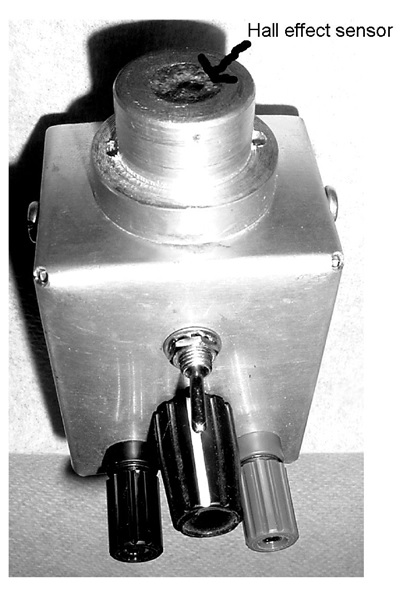

by Tom Carnegie
When rebuilding a model T flywheel, it is usually a good idea to recharge the magnets. The procedure to ascertain the strength of the individual magnets usually involves picking up a piece of iron with said magnet. It is possible for a weaker magnet to pick up more weight than a stronger magnet under certain circumstances. If you desire a way to find out the comparative strength of each magnet a gauss-meter would come in handy. It is fairly easy and inexpensive to make an uncalibrated electronic gauss-meter. The poor man's gauss-meter uses a hall-effect sensor. A hall-effect sensor detects changes in magnetic flux in real time. Although this meter will not be calibrated, it will be close and certainly will make accurate comparisons between different magnets.
Parts needed:
* 2ea. - 9 volt batteries
* 2ea. - 9 volt battery clips
* 7805 voltage regulator (5 volt)
*A3516LUA hall-effect sensor (this is an uncalibrated unit.
Calibrated units are available, but they are more expensive)
* LT1009 adjustable voltage regulator (2.5 volts)
* 3.6K resistor
* 10K potentiometer
* Project box
* DPDT switch
* Volt meter
The circuit is very simple. I just bread boarded the one I built and stuffed it into a project box from Radio Shack. It consists of two parts. The left half is the hall-effect circuit. The hall-effect unit (A3516) takes the 5 volts from the 7805 regulator and splits it into two. With no magnetism present the A3516 will output 2.5 volts. Magnetism present will make it either read higher of lower than 2.5 volts depending on whether or not it is a north or south pole. The right hand half of the circuit is a 2.5 volts biasing circuit to offset the 2.5 volts from the hall-effect circuit. The potential between the output of the hall-effect circuit and the biasing circuit will be zero (more or less) with no magnetism present. The 10K potentiometer will trim the offsetting voltage for an exact zero reading. A volt meter is then used to read the gauss readings directly. A reading of 2.5 volts on the volt meter equals 2500 gauss (more or less). As mentioned earlier the A3516 is not calibrated so the measurement is not 100% accurate.
I don't know how accurate it is, but for my purposes it doesn't matter as I am just looking for a quantitative comparison between two magnets. I mounted the A3516 into a tube and encased it with epoxy, then attached it to the project box. Either flat side of the A3516 is sensitive to magnetism. This gauss meter is sensitive enough that it will act as a compass. The meter will read slightly positive or negative depending on which way you are facing. It is sensitive enough to read the magnetism of the flywheel magnets through the hogshead, which might come in handy if you are charging magnets in the car. I want to thank Rick Hoadley who gave me the idea for this project. If anyone wants to take a crack at this I can help you get the solid state devices and answer questions.

